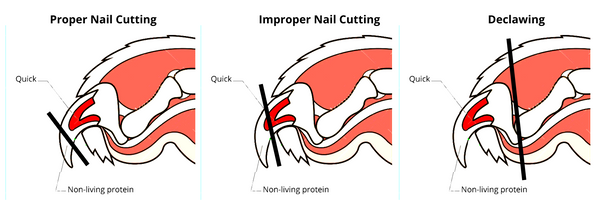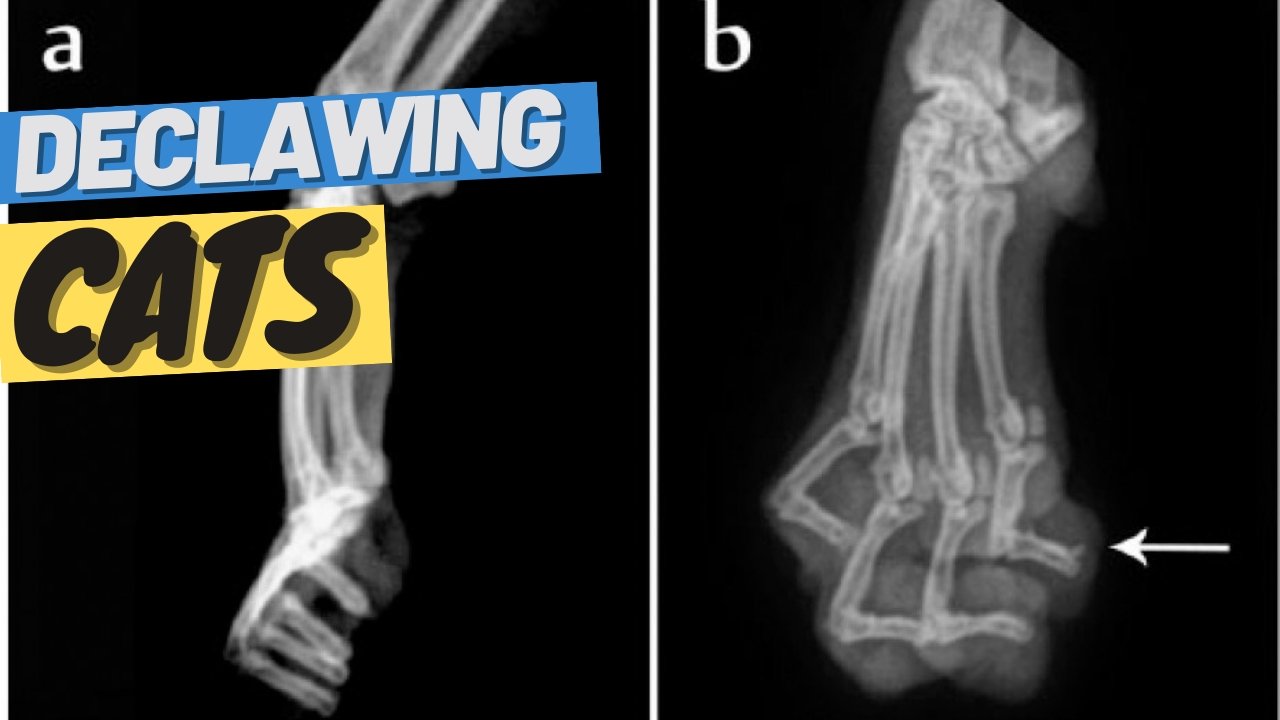Cat declawing (onychectomy) was first introduced in the late 1940s in the United States. It became popular in the 1950s and 1960s as more people brought cats indoors. Declawing cats gained even more traction in the 1970s and 1980s, when veterinarians started offering it as a routine elective surgery, often performed at the same time as spaying or neutering.
There's no cat owner that has not complained at some point about their cats' behavior. Most (if not all) cat misbehavior comes from cats lacking enrichment or needs they would be able to fulfill in the wild.
What might look like cat misbehavior for humans, it's generally cats fulfilling their basic needs with what they have available.
There are a bunch of behaviors that humans consider misbehavior:
- Scratching Furniture
- Jumping on the Counter
- Eating Plants
- Biting and Scratching their Guardians
- Not Sleeping Through the Night
Scratching is a normal, inherited feline behavior; however, when the scratching is directed at the owner, other pets, or household objects such as drapes or furniture, it becomes unacceptable.
Declawing can be used effectively to correct the most undesirable scratching. But, while declawing might prevent the behavior consequences (limiting the cat's ability to scratch) there are frustrations and complications for a cat that's been declawed, which could trigger other types of misbehavior.
There are better ways to stop cats from misbehavior, and treating the causes and disciplining a cat it's always better than trying to manage the consequences.
In this article, we will discuss everything about declawing and why it is harmful to your cats.
What's Cat Declawing?
Feline declawing is an optional and ethically conflicting surgical procedure that is rarely medically necessary for cats. There are many misconceptions about declawing. While many think the procedure consists of removing the nail from the toes, the actual procedure is an amputation of the front part of the finger. The finger is broken into three separate bones P1, P2, and P3. The vet will articulate the last P3 bone from the two other bones.
It is frustrating for cats and affects their ability to interact with the environment like they normally would.
Declawing your cat is an idea that people in different parts of the world have very different thoughts. In some countries, it's a routine thing to do. While in other countries, it's illegal to do.
In the United States of America, declawing was a procedure done for indoor cats and is now considered a cruel practice. Cats aren't good at expressing their pain, and it seems like an operation that was more intrusive than people thought.
How does the Declawing Surgery Entail?
This procedure consists of the amputation of the last bone of each toe. In more technical terms, the procedure of Onychectomy consists of the amputation of the distal phalanx.

For different procedures of declawing, the vet will use a scalpel blade. With a scalpel, the vet makes incisions to remove the ligaments from the last flange to the middle flange. They can also use a laser. The laser will also stop the bleeding, reduce inflammation, and causes the least amount of pain.
The last procedure is called the Roscoe clipper technique or a guillotine technique. The vet will use a blade and cut through different ligaments. There is a high possibility of botch surgery, where the vet can break certain parts of the bone and leave that bone in tissue. It can cause a lot of pain and discomfort and potentially even a follow-up surgery.
No technique or method has been proven to eliminate the many complications associated with declawing.
Is it Cruel to Declaw a Cat?
Declawing is not just a fancy manicure. It is the removal of the third bone in a cat's toes, an equivalent of amputating the last bone in your fingers at the knuckle. "Declawing" is a benignsounding term. When people first hear the word, they usually think it means some sort of clawclipping, not a series of ten amputations that leave the cat without the end of her front paws.
Cats scratching is a natural behavior cats do to clean and care for their nails but also to remove stress and mark territory.
The anatomical changes in the cat after declawing often lead to a cat suffering chronic pain. Many cats will also experience psychological changes and frustration that can turn into bad behaviors such as being aggressive or spaying.
The process is illegal in many countries. In the United States, declawing is outlawed in:
- Austin, Texas
- Denver, Colorado
- the City of St. Louis and St. Louis County
- Missouri, Texas
- Pittsburgh and Allentown, Pennsylvania
- Madison, Wisconsin
Even in areas where declawing is legal, veterinarians choose not to perform such practices.
Are Declawed Cats Happy?
Declawing is a painful surgery for cats. Not only the procedure, is excruciating, but the recovery process is also unpleasant.
The procedure of declawing is torturous to cats, leading to pain and mobility issues. It also takes away their natural defense mechanism, making them stressed. Cats with such procedures can develop aggressive behaviors in their constant vulnerability state.
Declawed cats will need more custom enrichment.
Does Declawing a Cat hurt them forever?
Research done by the Journal of Feline Medicine and Surgery studied 137 declawed and 137 non-declawed cats.
They learned that declawing cats increases the risk of unwanted behaviors and may increase the risk of developing back pain. Evidence of inadequate surgical technique was common in the study population.
Among declawed cats, retained P3 fragments further increased the risk of developing back pain and adverse behaviors. The use of optimal surgical technique does not eliminate the risk of adverse behavior subsequent to onychectomy.
Also, removing the joint from the toes is very hurtful for the cats. Cats are tip-toe walkers meaning that they walk on their toes. The moment you perform this procedure, they go flat-footed immediately.
Finally, declawing can lead to several issues physically, the way the catwalks and maintaining balance. The other problem with this is that the cats can often develop arthritis in the ends of their fingers, leaving them in chronic pain.
Cons of Declawing Your Cat
Because this is an invasive procedure that affects the cat's anatomy, there are a lot of cons to declawing your cat:
Psychological Changes:
There is little published information regarding the long-term health effects of declawing in the cat. The study mentioned earlier shows a clear association between declawing and the presence of deleterious side effects after the typical postoperative period in a comparatively large sample population.
The cats will often change their behavior post-surgery. They can become aggressive and reclusive and eventually will start biting. Cats are defensive animals. When feeling threatened, the first thing they're going to do is hold up their paw and make sounds. Then there go to bat with their claws out if they feel threatened, and finally, if none of that is working, they bite. If all of this is taken away by declawing, they will bite first.
Marking:
The study also showed that the odds of the highly undesirable habits of elimination, periuria, and/or perithecia were much greater in declawed cats than in non-declawed cats.
There are several hypotheses that try to explain why:
If the source of pain is declawed phalanges, the act of walking on or digging in a gravel-type substrate may result in pain and aversion to the use of the litter box. Many cats that eliminate outside of the litter box choose a soft substrate such as carpet, clothing or a location next to the litter box like a mat.
Defenselessness:
Cats use their front paws as their first line of defense against predators and are also crucial for climbing trees if they decide to flee.
An outdoor cat that has been declawed has lower odds of successfully avoiding an attack from a dog or another land predator.
Alternatives to Declawing Cats
If you are concerned about your cat ripping up furniture, which is a common thing, there are many better options than declawing your cat.
Correcting any cat behavior consists of 3 phases:
- Understand why they are exhibiting the behavior (What they choose, in which areas)
- Offer an adequate alternative (similar materials, in similar areas)
- Reward them when they use the alternative
My recommendation is that you go ahead and put several scratching posts and boards throughout the house. There are different types of scratchers, vertical, horizontal, and made of sisal or cardboard. Use several types until you discover which ones are preferred by your cat.
Cat trees are also an amazing weapon to keep your cat/s happy. They take up a lot of space and they can be pricy but they are totally worth it.
Clipping your cat's nails. This will reduce the damage they can make to your furniture but won't necessarily stop the scratching.
Finally, although I'm not a big fan because it limits your cat's ability to scratch, you can also use nail caps that you can put on the cat's nails. They last depending anywhere from two weeks to four weeks. You do have to glue them on, it's not painful for the cats, and it is something that does require regular reapplication. It's not ideal, but far better than declawing.
Organizations that are Against Declawing Cats
Numerous organizations oppose declawing, including:
- The Humane Society Veterinary Medical Association
- The International Society of Feline Medicine
- The Small Animal Veterinary Association
- The American Association of Feline Practitioners
Treat the causes before the symptoms and you'll have a happy cat in a happy house!
I hope this helps you make the right choice about declawing or not your cat.
Stay Wild, Stay Safe... We'll see you outdoors!
Albert & Mia
Martell-Moran NK, Solano M, Townsend HG. Pain and adverse behavior in declawed cats. Journal of Feline Medicine and Surgery. 2018;20(4):280-288. doi:10.1177/1098612X17705044


0 comments